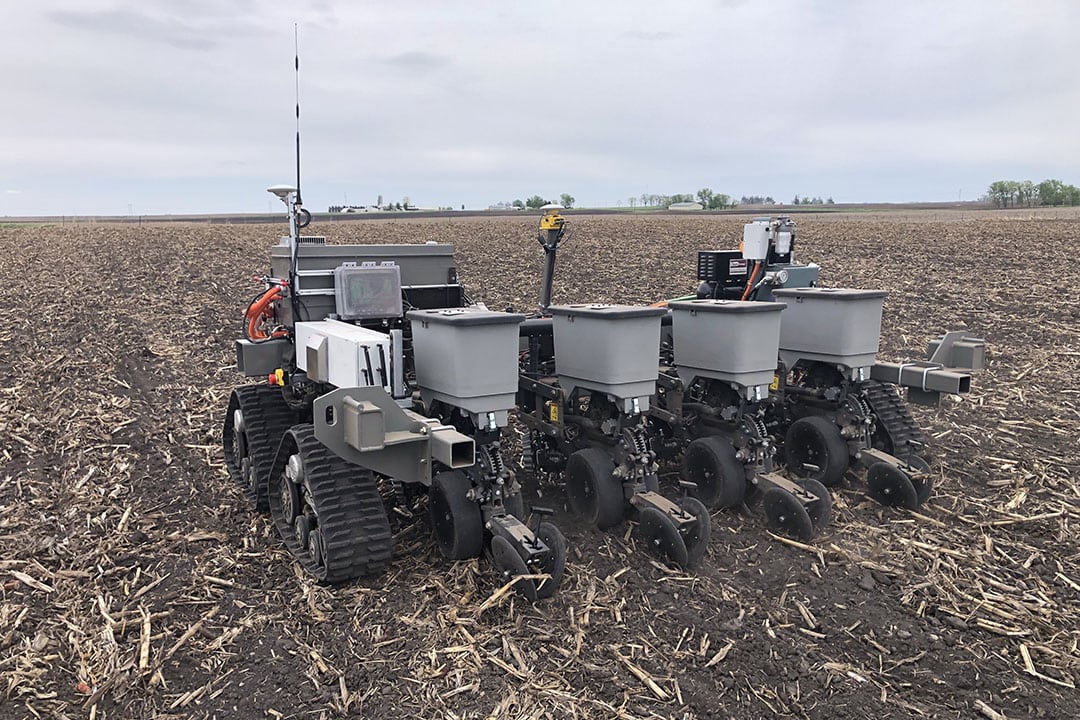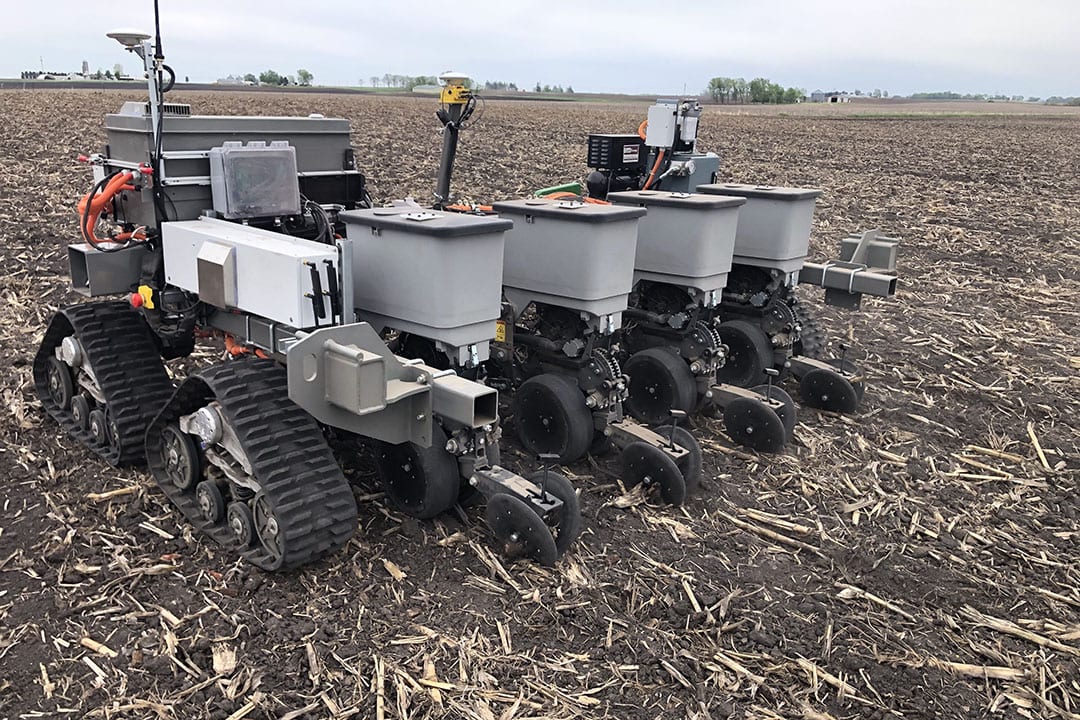Technology update: automated planting with Salin 247

The Salin 247 crop production machine has just finished a year of extensive testing with automated planting. Here’s what’s ahead.
Development of the Salin 247 electric autonomous crop production machines continued in 2022, with commercialisation expected in 2024, says CEO Dave Krog. Already in 2021, a Salin 247 prototype (V1) was able to plant in a field by itself near the company office in Ames, Iowa, US.
Third prototype of Salin 247
“We are currently building our third prototype, V3, and will have it in the field this spring with a 4-row planter and a nitrogen side-dress applicator,” he reports. “We designed V3 based on our V2 experience in the field and based on a lot of feedback from growers.”
The V3 machine will have a custom-built suspension system and wheels instead of tracks. It will also have an adjustable wheel base width and a higher-capacity cooling system. The planter of this newest version of the robot will also have a dust-proof enclosure for the vacuum system and row-by-row down force.
Plant, apply fertiliser and crop protection products
The Salin 247 is an autonomous robot that can plant, but also will have the capacity to apply fertiliser and crop protection products. It can plant four rows at once of any crop that a standard planter row unit can plant. A ‘seed drill’ type planter or a broadcast planting option could be added in the future.
The speed is about 5.5 miles per hour, which translates to planting about 5 acres per hour. The second prototype weighs about 1800 kg. The four-motors output is 20 kW (about 27 hp), powered by a 10-kWh lithium iron phosphate battery.
“We expect to be able to run 8 to 10 hours before needing to refuel the generator,” says Krog. “We will be using a generator to keep the batteries charged and will not need to do battery swapping.”
Text continues below image

Autonomy
In terms of the autonomy, once it is commercially available and arrives at a farm, the Salin 247 system proprietary software accesses and confirms digital field shape/boundary files that farmers already have on hand. This includes waterways, drainage intakes and so on. The software then generates a traffic pattern for each field that the machine will follow for planting, based on farmer requirements and integrated with GPS.
The automated movement of the machine is accomplished using standard ROS (robotic operating system) open-source code that’s similar to that of tractor ‘autosteer’ systems.
2022 tests
Krog and his team – including his son Ben who is a mechanical engineer – had planned to have the V2 plant about eight fields of 20 to 50 acres each in 2022 with corn and soybeans. In Tennessee, there’s double cropping of soybeans so there were plans for planting in that fashion as part of the AgLaunch365 ag tech accelerator program, which has supported Salin 247 in its startup phase.
Reflecting on the successful tests of 2022, Krog says that the cool, wet spring weather in Iowa delayed planting by about a month.
“We ended up testing on four Iowa farms, two Tennessee farms and one Kansas farm,” he reports. “We only planted soybeans. Six of the seven fields we planted were no-till fields. In Tennessee we planted double crop soybeans into wheat stubble. In early July, we planted a double crop soybean field near Fort Scott, Kansas.”
Precision Planting technologies
They are using many of the planting technologies made by Precision Planting, including SmartFirmers, vDrives, and vSets (but not currently their SmartDepth product).Overall, Krog and his team were “very happy” with the robot’s performance.
At the same time, he says, “we did have some challenges with compacted soil. Our planter was a bit too light to keep the double-desk openers in the ground in some locations, so we had to add weight.”
Indeed, primarily due to operating on compacted soils, from his analysis of a large amount of energy use data gathered during 2022, Krog notes that energy use was higher than predicted.
Text continues below image

Hybrid energy model
Therefore, “based on the data we collected, we have decided to pursue a hybrid energy model where we continue to use electric drive motors but rely on a diesel generator to supply the needed power,” Krog says.
However, in 2022, there was trouble sourcing the needed diesel generator that runs on biodiesel. Krog explains, “So this year we will again likely use a gasoline-powered generator to keep the battery charged. The plan starting next year is to use a diesel engine running on B100 (100% biodiesel) that directly powers the electric drive motors. This is the same approach used by train locomotives. With this approach, we will still have a battery, but it can be smaller.”
Preventing soil compaction with Salin 247
Returning to compaction, preventing further soil compaction has always been a goal with Salin 247. Krog explains that V2 of the robot had a track turning system, which provided a very low weight underneath the tracks of only 2 psi and greatly reduces compaction. Use of tracks also – in combination with the very light weight of the robot itself – means that operations like post-emerge spraying and side dressing can be carried out in fields even right after it rains.
(In parallel with this, Salin 247 has no plans to use tillage equipment, as it’s very heavy and therefore contributes to soil compaction in addition to requiring more energy to pull. Krog wants to support no-till crop farming as it’s much better for soil structure and health.)
Turning aspect is a challenge
But while tracks provide these important benefits, the turning aspect is a challenge. Over the past two years, Krog and his team spent a lot of time testing the best way to turn to minimize disturbance to the soil, with wide circle turns and also sharp small turns with one track going forward and the other going backward, similarly to how a skid steer works.
In 2023, we will continue to use a skid steer approach, but we are going to use wheels instead of track
Now, after all this research, Krog reports that “in 2023, we will continue to use a skid steer approach, but we are going to use wheels instead of tracks. For now, the drive motors will be the same size as V2 although we will be using 50:1 gear boxes instead of 20:1 as the higher gear ratio is needed for wheels versus tracks. In the future however, our machines will use all-wheel steering and with that approach, we will be able to once again use tracks.”
Fertiliser application with Salin 247 and more
As mentioned, the V3 Drive Unit will also be used to power a side dress liquid nitrogen fertiliser applicator that’s in development. It involves an attached boom and tank. Another firm called AgLeader has been “quite helpful,” says Krog, with the configuration.
Krog wants to enable growers to apply more of their N fertilizer in-season as it’s one way to help growers reduce the so-called Carbon Intensity (CI) scores of their corn production. He says “a successful proof-of-concept [of our applicator] will be an important first step towards increasing in-season nitrogen applications on millions of corn acres in the years ahead.”
Similarly to how the Salin 247 plants, it will apply N side dressing or crop protection products through GPS guidance, using system records of where the plants are located (where the seeds were planted) and probably computer vision also. Krog says this will allow the machine to ‘see’ the size and shape of the plants in order to fine tune navigation and application.
Text continues below video
Testing with Salin 247 in 2023
This year the Salin 247 will be put through its paces with the Iowa Soybean Association in an on-farm trial project on ten farms, evaluating row width and seed populations. Krog and his team also continue to develop a docking station where the machine will go to automatically re-fill its hoppers or tanks with seed, fertiliser and crop protection products as needed.
They will also be testing sensors already research for adding machine vision, radar and other methods of detection to ensure the Salin 247 is able to detect any new objects that may happen to come into a field, and stop as appropriate.
Commercial availability
And when will the Salin 247 be available in the market? That’s expected in 2024. The plan is to release the platform to market via a Farming-as-a-Service (FaaS) model. This means farmers will hire Salin 247 to do planting and post-emerge applications, and not purchase units themselves.
Krog continues to be very excited to be coming closer to helping farmers free up their time while also enabling them to farm crops with higher precision and less compaction.
As he’s stated in the past, there are automated systems being developed right now that involve tractors pulling implements, “but we wanted to power the actual implement. We’d like to do away with use of the crop farming model that relies on traditional, heavy tractors and other heavy field implements.”
Join 17,000+ subscribers
Subscribe to our newsletter to stay updated about all the need-to-know content in the agricultural sector, two times a week.



